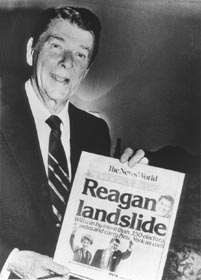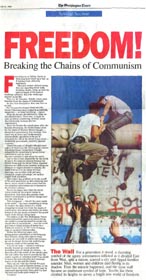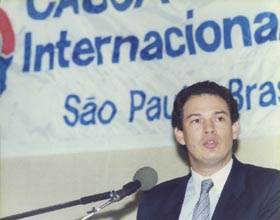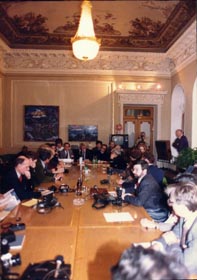1. Building a Media Network

|
| Ronald Reagan holding a copy of the News
World, which predicted Reagan's landslide victory on Election Day morning,
November 4, 1980 |
Certain policies pursued by
President Ronald Reagan in his efforts to end the Cold War stalemate met
opposition and derision in the establishment media. The President's effort to
follow through on President Jimmy Carter's commitment to deploy ground-launched
cruise missiles and Pershing II intermediate range missiles in Western Europe
resulted in media criticism and a storm of protests in both America and Europe.
President Reagan's advocacy of the Strategic Defense Initiative was derisively
referred to as "star wars" in the press and viewed as destabilizing the delicate
balance of power, thus escalating the threat of nuclear war. Reagan's support of
the Nicaraguan contras met with decided opposition as did his description of the
Soviet Union as the "Evil Empire."11
 |
| The Washington Times was crucial in coverage
of the Cold War |
The international media network
created by Rev. Moon helped to demonstrate the viability of the Reagan Doctrine
and had an impact on key congressional votes. It also affected public opinion
and the establishment media's coverage of Cold War issues. Of the media projects
undertaken by Rev. Moon in the United States (which include The New York City
Tribune, New York's Spanish-language newspaper Noticias del Mundo,
and Insight Magazine, among others), the founding of The Washington
Times (1982) was certainly the most significant. The Times broke key
news stories on Soviet bloc operations, and sometimes brought to the front pages
vital Cold War issues which newspapers such as The New York Times and The
Washington Post chose to bury on back pages.12 The
Times highlighted Soviet human rights violations, did expansive features
on the public relations and lobbying activities of left-leaning organizations
such as the Christic Institute and the Institute for Policy Studies, and
frequently reported on the Soviets' nuclear build-up and their sizeable military
and logistic aid to national liberation movements in Asia, Latin America and
Africa. Within the first three years of its existence, The Washington
Times became one of America's most quoted newspapers.13
Three issues help to illustrate the Times' role in the Cold War:
Nicaragua, Gorbachev and the U.S. Congress, and SDI.
 |
| Pedro Chamorro of the Nicaraguan Resistance
addressing a CAUSA Seminar |
a. Nicaragua
One area of notable coverage was on the
anticommunist insurgency in Nicaragua known as the Contras. The
Washington Times' investigations and reportage lent credence to executive
and legislative efforts to support that Nicaraguan Resistence in its commitment
to derail that country's move into the Soviet-Cuban sphere of influence. For
example, from April 8 to 12, 1985, just prior to a crucial Congressional vote on
providing support to the Nicaraguan contras, the Times ran a five-part
expose on how Leftist grassroots networks were pressuring the U.S. Congress to
abandon the freedom fighters.14 When on April 24, 1985, the U.S.
Congress voted down a bill to provide $14,000,000 in humanitarian aid to the
Nicaraguan resistance, dealing a major geopolitical setback to the Reagan
administration, The Washington Times took the U.S. Congress to task,
announcing on May 6, 1985 its establishment of an infrastructure to seek private
humanitarian funding for the contras.15 The Times also announced
its decision to provide the first $100,000 seed money for the project.
Co-chaired by Jeane Kirkpatrick, William Simon, Midge Decter and Michael Novak,
the Times-initiated Nicaraguan Freedom Fund became national news-much to
the discomfiture of the Congress.16 In its news coverage, the
Times contrasted the Congressional negative vote with the subsequent trip
by Nicaraguan President Daniel Ortega Saavedra to Moscow, April 28-29, 1985 to
secure additional Soviet aid, and it also reported on new shipments of Soviet
military supplies to Nicaragua.17 The Times' strong focus
continued until the Congress reversed its position in June, resulting in a new
$27,000,000 commitment of humanitarian assistance to the Nicaraguan
resistance.18 American aid to the contras, as well as the provision
of stinger missiles to the Mujahadeen in Afghanistan which the Times also
strongly supported, were decisive factors in the eventual wearing down of the
Sandinistas in Nicaragua and in the Soviet decision to abandon Afghanistan.
b. Strategic Defense
Initiative (SDI)
On November
1, 1983, The Washington Times did a high profile, full-color article on
this space-based anti-missile system and on one of the projects' key supporters,
Lt. General Daniel O. Graham.19 In its editorial policy, the
Times rigorously and frequently advocated the system's development.20 Indeed,
when President Reagan unveiled SDI in a March 23, 1983 TV address, the Times
editorialized that this address was "maybe President Reagan's best ever,"
stated that the idea of a space-based shield has "had our interest and support
for months" and cited its potential leverage in future arms
negotiations.21 This advocacy can be contrasted with the position
of The New York Times, which strongly called for restraints on SDI's
development.22 Reflecting the debate of the time, The New York
Times further denigrated both the program and Reagan's position on its
development and deployment with such terminology as "a pipe dream, a projection
of fantasy into politics," "science fiction," and "dangerous folly," and
concluded that Reagan left the impression that SDI is "a harebrained adventure
that will induce a ruinous race in both offensive and defensive
arms."23 Regardless of U.S. internal debate on SDI's efficacy,
the fact remains that President Reagan's unswerving commitment to this program
(and the support of publications such as The Washington Times)
contributed to a shift in the Soviet Union's handling of the nuclear issue
vis-a-vis the United States.24
c. Gorbachev and the U.S. Congress
In November of 1987, The
Washington Times ignited a nationwide controversy which resulted in a
rescinding of plans to have Mikhail Gorbachev be the first communist leader to
address a joint meeting of Congress. This privilege had previously only been
extended to foreign dignitaries who were strong allies of the United States such
as Lafayette, Winston Churchill, Margaret Thatcher and Francois Mitterand.
Nonetheless, the White House and Democratic congressional leaders apparently had
negotiated behind the scenes to afford this honor to President Gorbachev on
December 9, during the Reagan-Gorbachev Summit in Washington, D.C. The
Washington Times' breaking of this story (first broached on November 13 and
headlined on November 17), and its follow-up coverage and editorializing helped
to generate a furor among conservative lawmakers.25 The
swelling chorus of opposition led the White House and the congressional
supporters of the invitation to begin backpedaling by November 20 and to totally
abandon plans for the address by November 22. In the months following this
public embarrassment, President Gorbachev took a number of steps, including his
announcement to withdraw Soviet troops from Afghanistan, which clearly
established glasnost as more than a political ploy.
That the Times would play such a pronounced role in the Cold War was
apparently intuited by affected parties from its inception. Neither the Soviet
nor the Chinese governments allowed the Times to open a news bureau in
their capitals. The radical left newsletter Overthrow in its June/July
1982 issue called for sabotage of The Washington Times
26,
and the Times was subjected to frontal attacks in leftist publications
such as CovertAction and CounterSpy.27 On the
other hand, it was reported that Ronald Reagan made a practice of reading The
Washington Times every morning28 and The Washington Times
was credited with certain of President Reagan's responses to critical foreign
policy issues, including the 1985 forced landing and apprehension of Palestinian
terrorists responsible for the hijacking of the Achille Lauro and the
cold-blooded murder of American businessman Leon Klinghoffer.29
d. The Washington
Times' Impact on other World Media
The impact of Rev. Moon's Washington Times
extended to the news disseminated worldwide, including in communist and
frontline countries. In 1988, Nobel peace laureate Oscar Sanchez Arias, then
president of Costa Rica, a country bordering on Nicaragua, told the American
Society of Newspaper Editors that Costa Rican newspapers depended on The
Washington Times for news of their world. He went on to say that the only
American newspaper Costa Rican citizens know exists is The Washington
Times, and that if Costa Rican newspapers published something from the U.S.
it was from the Times.30 In 1990, future Nicaraguan
President Violeta Chamorro Barrios, owner of La Prensa, the only daily newspaper
which dared to defy Nicaragua's Sandinista government, confided to The New
York Times' editorial board that the Sandinistas themselves regarded The
Washington Times as "the newspaper of the Nicaraguan
opposition."31
Throughout the 1980's the World Media
Association (WMA), a media-related organization associated with The
Washington Times, provided journalists from numerous publications with
first- hand exposure to numerous vortices of the Cold War. In 1983, WMA brought
155 journalists, from 55 countries, to visit sites on the border of Nicaragua
and Honduras, including refugee camps and the track known as "Blood Alley" which
two days after the Media Association tour was the site where Sandinista solders
killed two American journalists. That same year, journalists were brought to
Europe by WMA to report on the Nuclear Freeze Movement and afforded the
opportunity to cover the October 22 massive demonstration in Bonn against NATO's
planned deployment of Euromissiles. During the same tour, a side visit to East
Berlin by WMA allowed journalists to observe a plethora of East German posters
opposing the deployment of US cruise missiles, and a total absence of any
criticism against the presence of Soviet SS 20's on East German
territory.
 |
| American journalists sponsored by the World
Media Association visit the Soviet Union |
In 1984, WMA sponsored a journalist fact-finding tour focusing on the
Southeast Asia front lines, including a trek inside communist Kampuchea to meet
with leaders of the Khmer People's National Liberation Front who were resisting
the large Vietnamese military presence in their country. Other fact-finding
trips included encounters with leaders of RENAMO, UNITA, SWAPO and Solidarity.
The WMA tours, which often also included meetings with heads of state and
detailed government briefings, provided journalists access to first-hand
information on the status of communism, largely validating the salience of the
Reagan Doctrine.






